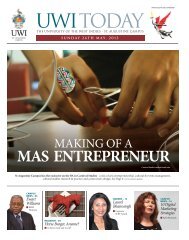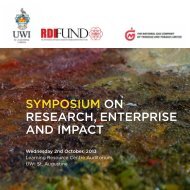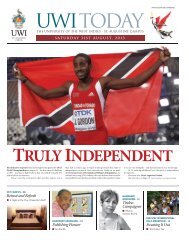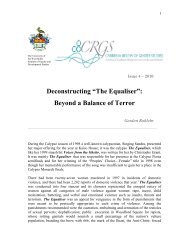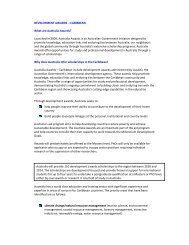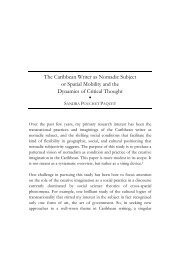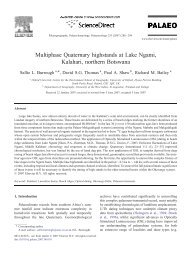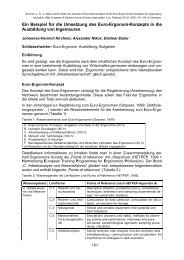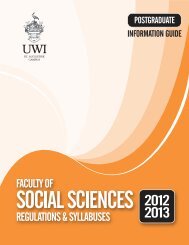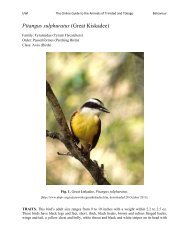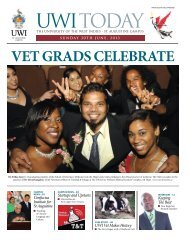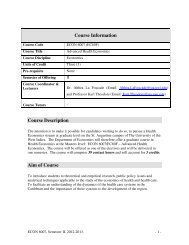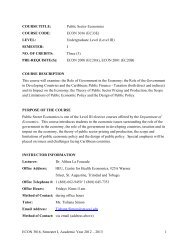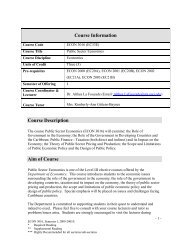Faculty of Humanities and Education (Postgraduate) - The University ...
Faculty of Humanities and Education (Postgraduate) - The University ...
Faculty of Humanities and Education (Postgraduate) - The University ...
Create successful ePaper yourself
Turn your PDF publications into a flip-book with our unique Google optimized e-Paper software.
102<br />
POSTGRADUATE REGULATIONS & SYLLABUSES 2012 - 2013<br />
THE FACULTY OF HUMANITIES & EDUCATION<br />
YEAR:<br />
SEMESTER:<br />
COURSE CODE: EDRL 6003<br />
COURSE TITLE: TEACHING READING IN THE CONTENT<br />
AREAS<br />
NUMBER OF CREDITS: 4<br />
COURSE DESCRIPTION: This course, Teaching Reading in the<br />
content Areas, is essentially about models <strong>and</strong> strategies for<br />
delivering reading instruction to students at the secondary<br />
level. It is also about ways <strong>of</strong> judging the match between<br />
students, texts <strong>and</strong> contexts, as well as about methods <strong>of</strong><br />
guiding content area teachers toward fostering environments<br />
in which both struggling <strong>and</strong> non-struggling adolescent readers<br />
can thrive. It is delivered partly through lectures supported by<br />
online delivery components <strong>and</strong> partly through workshops<br />
supported by online delivery components. Its purpose is to<br />
equip participants with the knowledge <strong>and</strong> skills necessary for<br />
using diagnostic information in planning <strong>and</strong> implementing<br />
instructional strategies, assessing the outcome, <strong>and</strong> providing<br />
feedback to students to facilitate the improvement <strong>of</strong> contentarea<br />
reading competence.<br />
Prior to taking this course, participants must complete two<br />
(Semester 1) courses in reading: <strong>The</strong>oretical Foundations <strong>of</strong><br />
Reading <strong>and</strong> Reading Diagnosis, Intervention, <strong>and</strong> assessment,<br />
both <strong>of</strong> which provide the content basis for the application <strong>of</strong><br />
the technologies in the current course.<br />
CONTENT<br />
Content is comprised <strong>of</strong> content-area reading foundations <strong>and</strong><br />
Strategy workshops.<br />
Foundations<br />
<strong>The</strong> following topics will be addressed:<br />
Background to content area reading instruction<br />
Key abilities in dimensions <strong>of</strong> content area reading ability;<br />
factors accounting for differences in ability<br />
Assessment in content area reading<br />
Instructional models<br />
Strategy workshops<br />
<strong>The</strong> following topics will be addressed:<br />
• Global planning; frames <strong>and</strong> units<br />
• Pre-reading strategies – activating prior knowledge;<br />
interest <strong>and</strong> motivation; active reading<br />
• Pre-reading strategies – word identification; meaning<br />
vocabulary<br />
• Guided strategies during reading – comprehension (text<br />
organization; visual summaries/graphic organizers); metacomprehension;<br />
active reading strategies (questioning<br />
<strong>and</strong> answering strategies); metacognition (monitoring <strong>and</strong><br />
fix-up strategies)<br />
• Group interactions <strong>and</strong> text – jigsaw; reciprocal teaching<br />
• Post-reading strategies – reinforcing <strong>and</strong> extending<br />
• Study strategies – fostering independence<br />
• Developing curriculum-based assessments (CBAMS).<br />
General Objectives<br />
In order to achieve the course goal, the participants will:<br />
1. formulate a sound rationale for weaving reading instruction<br />
into content area teaching/learning.<br />
2. readily apply useful instructional models, strategies, <strong>and</strong> tools<br />
for developing <strong>and</strong> fortifying reading skills while fostering<br />
the development <strong>of</strong> content area reading expertise.<br />
3. apply a variety <strong>of</strong> instructional configurations in delivering<br />
reading instruction.<br />
4. use appropriate research-based tools to determine students’<br />
content area reading level <strong>and</strong> to determine appropriacy <strong>of</strong><br />
content area reading materials for specific groups.<br />
5. provide appropriate pr<strong>of</strong>essional development <strong>and</strong> support<br />
for content area teachers.<br />
6. locate or devise tools for monitoring content area teachers’<br />
level <strong>of</strong> implementation <strong>of</strong> reading strategies <strong>and</strong> practices<br />
in the regular classroom.<br />
Course Assessment<br />
Coursework will be worth 40% <strong>and</strong> will comprise<br />
• A discussion forum (on aspects <strong>of</strong> reading instruction or the<br />
reading process) (5%)<br />
• Displays <strong>of</strong> creations that support different aspects <strong>of</strong> reading<br />
development (10%)<br />
• Three article reviews (15%)<br />
• Group presentations on a unit <strong>of</strong> 5 lessons in a content area.<br />
(10 %).<br />
<strong>The</strong> final examination will be <strong>of</strong> 3 hours’ duration <strong>and</strong> be worth<br />
60% <strong>of</strong> the total marks. <strong>The</strong> questions will address links between<br />
theory <strong>and</strong> best practice <strong>and</strong> will also address contributions to the<br />
development <strong>of</strong> best practices in particular areas <strong>of</strong> reading.<br />
Resources<br />
Biancarosa, G., & Snow, C. E. (2006). Reading next A vision for action<br />
<strong>and</strong> research in middle <strong>and</strong> high school literacy: A report to<br />
Carnegie Corporation <strong>of</strong> New York (2nd ed.).Washington, DC:<br />
Alliance for Excellent <strong>Education</strong>.<br />
Dobbs, O. (2003). Using reading strategies to reduce failure<br />
rate in the content area. ED479208. Retrieved from<br />
http://eric.ed.gov/ERICDocs/data/ericdocs2sql/content_<br />
storage_01/0000019b/80/1b/47/3b.pdf<br />
Mckenna & Robinson. (2009). Teaching through text: Reading <strong>and</strong><br />
writing in the content Areas. Allyn & Bacon:<br />
Moats, L.C. (2001). When older students can’t read. <strong>Education</strong>al<br />
Leadership, 58(6), 36-40.<br />
Moore, D. W., Readence, J. E., & Rickelman, R. J.. (2003). An historical<br />
exploration <strong>of</strong> content area reading instruction. Reading<br />
Research Quarterly, 18( 4), 419-438.<br />
Neufeld, P. (2005). Comprehension instruction in content area<br />
classes. <strong>The</strong> Reading Teacher, 59(4), 302-312.<br />
Vacca, R.T., & Vacca, J.L. (2007). content area reading: Literacy <strong>and</strong><br />
learning across the curriculum. Allyn & Bacon:<br />
Tierney, R.J., & Readence, J.E. (2004). Reading strategies <strong>and</strong> practices:<br />
A compendium (6th ed.)<br />
<strong>The</strong> Wilson Company (2002). Reading <strong>and</strong> writing in the content<br />
area. <strong>Education</strong>al Leadership, 60(3).<br />
Tompkins, G. A. (2010). Literacy for the 21st century: Teaching<br />
reading <strong>and</strong> writing in grades 4 through 8. Allyn & Bacon:<br />
Troia, G. A. (2006). Meaningful assessment <strong>of</strong> content-area literacy<br />
for youth with <strong>and</strong> without Disabilities, 31(69). Retrieved<br />
December 17, 2008 from http://aei.sagepub.com/cgi/<br />
content/abstract/31/2/69. Journals



